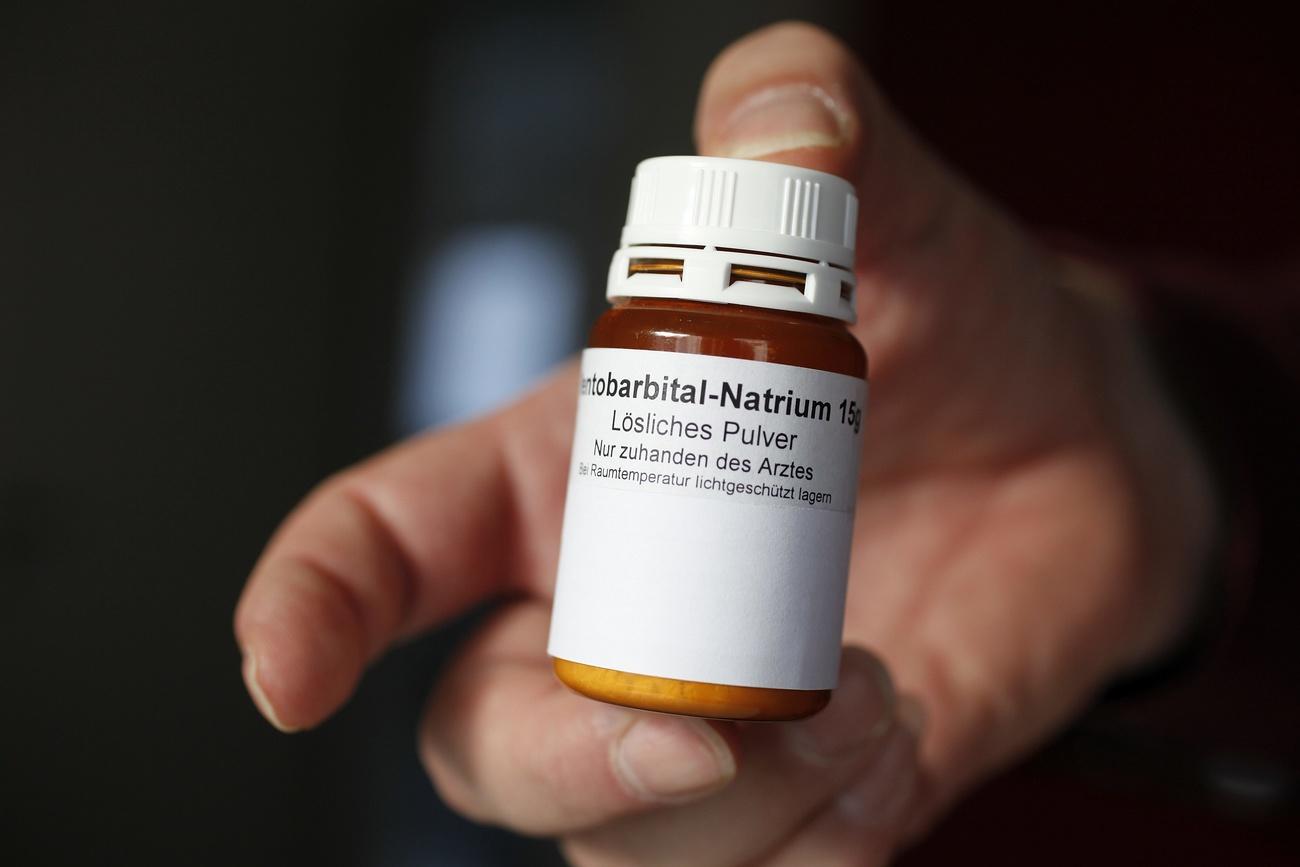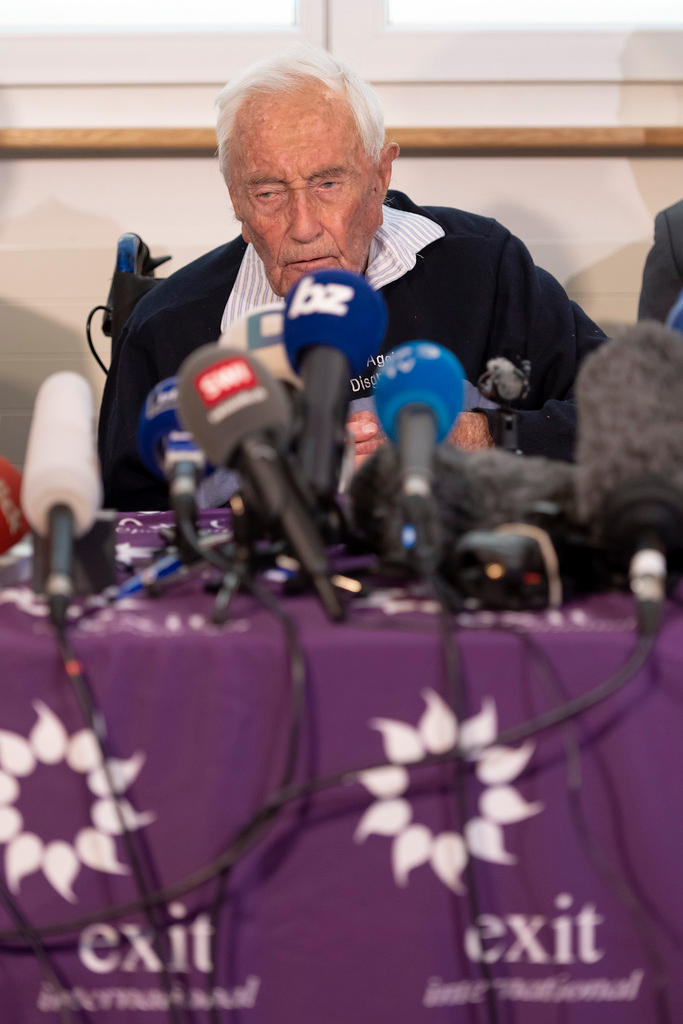The making of a right-to-die campaigner

Tom Curran spends a lot of time thinking about death: ways to die, places to die, and people who want to die. During his partner’s struggle to “avoid a bad death”, the Irish right-to-die campaigner found his calling, which has brought him close to Swiss assisted suicide organisations.
The former IT professional came to public attention in Ireland several years ago when his partner, Marie Fleming, took a landmark case to the Supreme Court challenging the country’s ban on assisted suicide.
She argued that, as a disabled sufferer of multiple sclerosis (MS), she had a constitutional right to receive assistance to die.
“I got educated with Marie. But it wasn’t so much that Marie wanted to plan for her death, she wanted to plan to avoid a bad death. And that’s what almost everybody we come across is doing. They want to know that they’re in control,” Tom explained.
The couple imported a deadly dose of the barbiturate pentobarbital from Mexico. This is the drug used legally in assisted suicides in Switzerland. “As soon as that arrived, she relaxed because she knew she could make that decision any time. And that was more than five years before she died.”
Marie was too unwell to attend the judges’ final ruling dismissing her appeal in April 2013. Eight months later, she died at home, never having received the legal assurance she wanted that Tom would not be prosecuted if he helped her to die.
Campaigning
Tom is now active on a wider stage in the right-to-die movement. He is one of three directors of Exit InternationalExternal link, an Australia-registered right-to-die organisation, formerly known as the Voluntary Euthanasia Research Foundation. Its founder, Philip Nitschke, nicknamed Dr Death, is now based in The Netherlands.
Before we met in Ireland, I had first arranged to interview Tom in Bern where he was due to accompany an English woman travelling to the Swiss capital. She wished to end her life with the help of one of the lesser-known Swiss assisted dying organisations, Ex International.External link However, the woman postponed her plans and the trip was called off.
Tom was present for the most widely publicised assisted suicide of recent years when the Australian scientist, 104-year-old David Goodall, came to Basel to die in May 2018 with the assistance of Exit International and a local organisation called Life Circle.
“We strongly believe that people should be in control of their own death. They shouldn’t be dependent on the medical profession and on getting permission to die,” Tom said.
Drugs and death capsules
One of Exit International’s main activities is to provide people with information on reliable and peaceful methods of suicide. This includes instructions on how to procure drugs on the dark web. Unsurprisingly, its activities have proved controversial.
Most recently, Exit International has been publicising an invention it commissioned, a 3-D printed euthanasia machine called SarcoExternal link which is currently on display in Italy at the Venice Design 2019 art exhibition.
Activated from the inside by the person intending to die, the capsule is flooded with nitrogen creating an oxygen-free environment which quickly causes a peaceful death.
Exit International has ties with the latest assisted suicide organisation to enter the Swiss sector, PegasosExternal link. Nitschke told swissinfo.ch that Exit International’s long-term aim is to use Sarco in Switzerland, possibly in collaboration with Pegasos. “We are getting advice on any legal obstacles.”
A spokesperson for Pegasos confirmed that representatives of the two organisations had met in Basel in October but that it was most likely that Sarco would be used with a different Swiss organisation.
“In six months’time we will all have a better idea of where Sarco will fit in to the big picture and any possible relationship with Pegasos.”
In the meantime, Nitschke will be taking the Sarco prototype on the road in Switzerland “to take some photographs” when the exhibition ends in November.

Life partners
Tom’s passion for the right-to-die movement comes from decades of experience caring for and trying to meet the needs of his partner. He and Marie met when they were in their thirties, both divorced and well established in their careers. Tom was working as an IT systems designer and project manager and Marie was a business lecturer at University College Dublin.
“From the beginning, we both realised that the relationship had the potential to be serious. She was in remission at the time and she told me about her MS. And she said the reason that she told me was that she wanted to give me the opportunity to leave.”
They spent the next 25 years together. When Marie’s symptoms became worse, she had to stop working. Tom was often away for days at a time for his job. It came to the point that Marie could no longer spend the days alone at home in their small rural cottage, so Tom gave up his job to care for her.
“The decider was when I came home from work one Friday and Marie had fallen. Luckily, she had only fallen that afternoon. She was on the ground for a few hours.”
“It was a difficult existence. Eventually we were just living on disability allowance and carer’s allowance so we had to adjust our lifestyle completely.”
Challenging times
More challenges lay ahead. As Marie’s illness worsened, she worried more and more about how her life might end. Eventually she was placed under the care of a palliative care team.
“Over the years there were lots of [illness-related] milestones, as we called them, and we laughed about them ourselves. At an earlier stage she would have said, I never want this to happen, I never want that to happen, but the milestones came and went because she was getting good care.”
Tom does not believe assisted dying and palliative care should be in opposition to each other. He is also involved with various organisations in the Irish palliative care sector.
“Numerous times I was told by the palliative care team that Marie was going to die that night. I’d say there was at least half a dozen times. But we nursed her and each time she was asked did she want to go and each time she said no so I made sure she didn’t.”
Despite the toll her illness took on Marie, the couple made the most of their time together. “Every year, even up to the last year, was a good year. Even up to the last day.” Tom declined to discuss the details of Marie’s last moments on the grounds of privacy.
‘It’s a right’
Today, Tom Curran’s project management skills are being fully exercised as he is currently planning a global right-to-die conference in Dublin next year.
Aside from the wider campaign, he is regularly reminded of the individual struggles of people who desperately want something that is against the law where they live.
Because of his profile in Ireland, he is often approached by people seeking help to travel to Switzerland. “This week alone, I got three calls from people. I don’t think they should have to travel but I can only accompany people in rare exceptions.”
Tom’s warm personality has an edge of missionary zeal. He has found his calling.
“We encourage people to plan well in advance. Buy their drug, put their method in place, whatever it is and to prepare for that well in advance so they don’t have to involve anybody else who might risk prosecution for helping them.”
Assisted suicide in Switzerland
Swiss law tolerates assisted suicide when patients commit the act themselves and helpers have no vested interest in their death. Assisted suicide has been allowed in the country since the 1940s.
Death is usually induced through a lethal dose of barbiturates that has been prescribed by a doctor. Ingestion of the poison, whether by drinking it or through the use of intravenous drips or stomach tubes, must be carried out by the person wanting to die.
A 2006 decision by the Swiss Federal Court ruled that all people of sound judgment, irrespective of whether they suffer from a mental illness, have the right to decide the manner of their death.
In June 2011, the government examined various options to regulate assisted suicide practices and decided not to seek legal changes but to boost suicide prevention and palliative care.
Switzerland has two main groups which cater to people who seek an assisted suicide, Exit and Dignitas, as well as other smaller groups.

More
Growing number of people sign up for assisted suicide

In compliance with the JTI standards
More: SWI swissinfo.ch certified by the Journalism Trust Initiative












You can find an overview of ongoing debates with our journalists here . Please join us!
If you want to start a conversation about a topic raised in this article or want to report factual errors, email us at english@swissinfo.ch.